February 2025
The global ski gear and equipment market size is calculated at USD 17.74 billion in 2025 and is forecasted to reach around USD 28.53 billion by 2034, accelerating at a CAGR 5.42% from 2025 to 2034. The North America market size surpassed USD 7.24 billion in 2024 and is expanding at a CAGR of 5.53% during the forecast period. The market sizing and forecasts are revenue-based (USD Million/Billion), with 2024 as the base year.
The global ski gear and equipment market size accounted for USD 16.83 billion in 2024 and is predicted to increase from USD 17.74 billion in 2025 to approximately USD 28.53 billion by 2034, expanding at a CAGR of 5.42% from 2025 to 2034. Growing due to increasing participation in winter sports, advancements in technology, and rising demand for high-performance and stylish ski apparel.
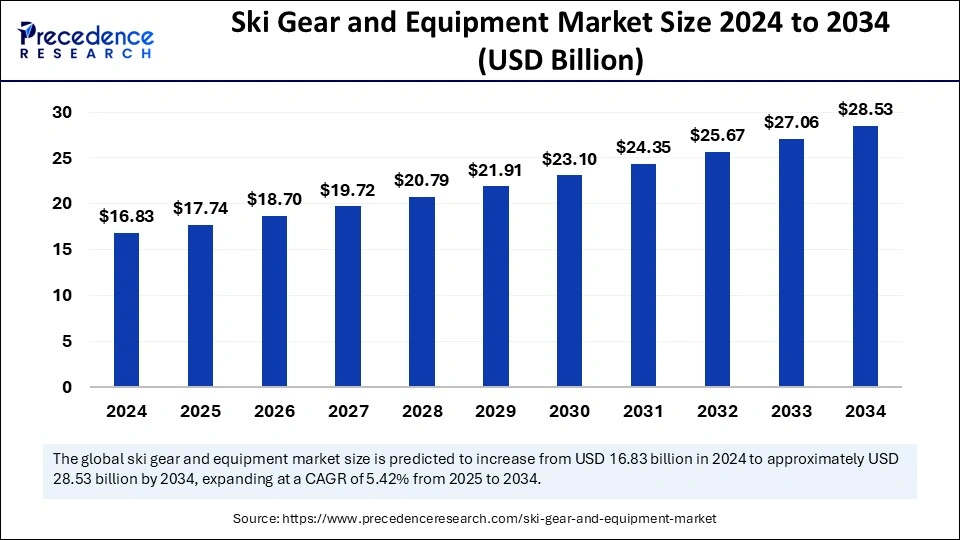
The ski gear and equipment market is being revolutionized by artificial intelligence through real-time data analysis and the use of smart equipment. Modern helmets now have impact sensors that can identify falls and notify emergency services right away, speeding up accident response times. By offering real-time weather updates, terrain mapping, and navigation support, augmented reality ski goggles improve visibility. The movements of a skier are monitored by wearable sensors that analyze posture and technique to help avoid injuries brought on by poor form. Furthermore, machine learning is used by automated avalanche detection systems to evaluate snow conditions and alert skiers to possible dangers. Together, these advancements reduce accidents and boost skier confidence, making skiing safer.
The U.S. ski gear and equipment market size was exhibited at USD 5.64 billion in 2024 and is projected to be worth around USD 9.74 billion by 2034, growing at a CAGR of 5.61% from 2025 to 2034.
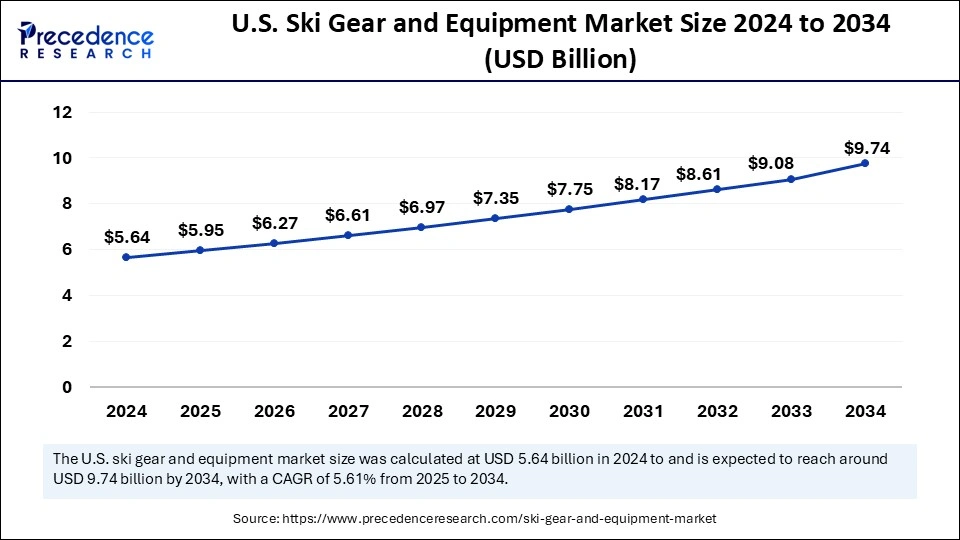
North America held the largest market share in the ski gear and equipment market in 2024 because of its extensive resort infrastructure, long-standing skiing culture, and high consumer spending on high-end gear. The area enjoys the benefits of a robust winter sports sector, with demand for high-performance gear being driven by occasions such as the Winter X Games and international ski tournaments. Furthermore, the popularity of backcountry skiing and snowboarding has spurred equipment innovation, thereby reinforcing North America's supremacy.
Europe remains a key player in the ski gear and equipment market, holding a notable share in 2024 due to its deep-rooted skiing traditions and well-established resort infrastructure. The Alps and other major ski destinations continue to attract millions of tourists each year, ensuring steady demand for high-quality ski gear. Moreover, sustainability initiatives such as eco-friendly ski apparel and equipment rental programs are gaining traction in the region, shaping future market trends.
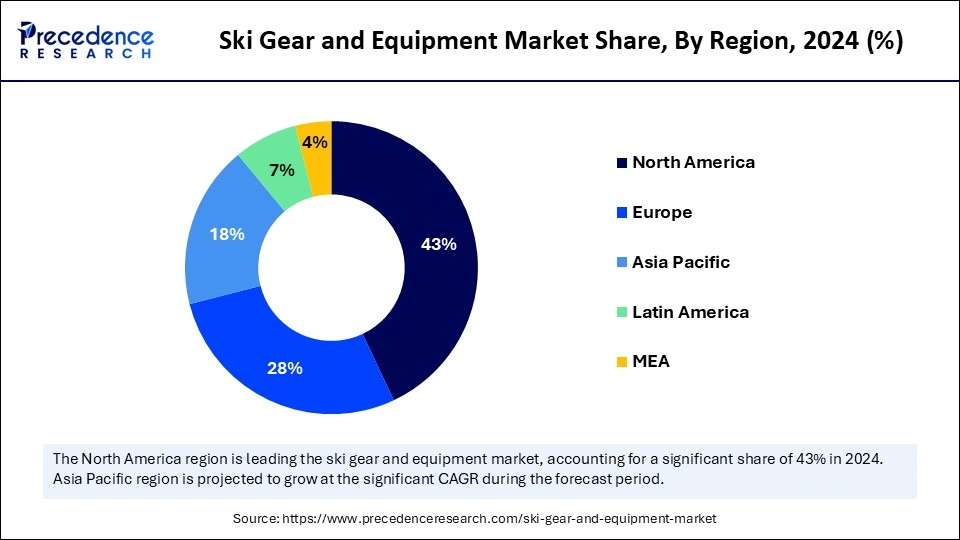
Asia Pacific is experiencing a rise in the ski gear and equipment market due to factors like growing disposable income, growing interest in winter sports, and government programs to promote ski tourism. By making significant investments in ski resort nations like China and Japan are opening the sport to a wider audience. Furthermore, a younger audience is driving demand for contemporary, fashionable, and technologically sophisticated ski equipment due to social media and international sporting events.
Singapore’s ski equipment industry caters mainly to outbound travelers, with no natural ski resorts. Gear is available from retailers like Decathlon and the North Face, and accessibility is increased by e-commerce platforms. Winter sports are introduced locally by indoor snow parks like Snow City, but most skiers would rather rent equipment overseas. Variations in seasonal demand continue to be significant.
India's ski gear and equipment market is expanding, driven by resorts in Gulmarg, Auli, and Manali in the Himalayas. The number of participants is rising thanks to government assistance and ski festivals. Even through high-end brands like Salomon and Rossignol are becoming more popular budget budget-conscious consumers prefer to rent equipment. Although there are still issues with inadequate infrastructure, future expansion is indicated by investments in ski training and artificial snow.
Growing interest in outdoor recreational activities, growing disposable income, and increased participation in winter sports are the main factors driving the global ski gear and equipment market. Skis, boots, bindings, helmets, and clothing are important items, and technological developments improve both performance and safety. Seasonal demand, travel patterns, and sustainability initiatives as eco-friendly materials become more popular, all have an impact on the market. Because of their well-established ski cultures, large brands compete through sponsorships, digital marketing, and innovations. Industry dynamics are further enhanced by rental services and secondhand markets.
| Report Coverage | Details |
| Market Size by 2034 | USD 28.53 Billion |
| Market Size in 2025 | USD 17.74 Billion |
| Market Size in 2024 | USD 16.83 Billion |
| Market Growth Rate from 2025 to 2034 | CAGR of 5.42% |
| Dominated Region | North America |
| Fastest Growing Market | Asia Pacific |
| Base Year | 2024 |
| Forecast Period | 2025 to 2034 |
| Segments Covered | Product, Application, Distribution Channel, and Regions |
| Regions Covered | North America, Europe, Asia-Pacific, Latin America, and Middle East & Africa |
Booming sky tourism
The massive investment in ski infrastructure by nations like China, South Korea, and Japan is turning it into a global adventure sport like never before. Luxury ski resorts and adventure packages are becoming more and more popular, drawing in both experienced and novice skiers. In addition, influencer-driven marketing ski festivals and competitions are increasing foreign travel to popular locations.
Tech-powered skilling
The slopes are being transformed by smart helmets, AI-powered ski trackers, and ultra lightweight equipment, while advancements in safety and comfort including heated ski boots GPS GPS-enabled goggles, and sophisticated shock absorbing materials. Apps for performance tracking are also becoming more and more popular, enabling skiers to evaluate and enhance their skills in real time. The use of augmented reality in ski goggles is revolutionizing training and navigation.
Seasonal dependence
Sales and resort operations are restricted to certain seasons, and the ski industry is largely dependent on the winter months. Shorter skiing seasons are a result of climate change and erratic snowfall patterns, which also impact demand and participation rates. Ski resorts invest in artificial snowmaking as a countermeasure, but this increases operating expenses and raises environmental issues. Due to the low demand for ski gear during the off seasons, brands and retailers experience irregular revenue generation.
Injury risks and safety concerns
Some prospective participants steer clear of skiing because of the high risk of injury. Concussions, ligament tears, and fractures are common injuries that discourage newcomers from participating in the sport. Manufacturers must invest in stringent testing and compliance with strict safety regulations and liability concerns that raise costs. Additionally, the fear of mishaps restricts participation, which impacts the demand for ski equipment as a whole.
Growth of eco-friendly and sustainable gear
Products that are environmentally conscious are becoming more and more in demand. Companies can draw in eco-aware customers by emphasizing biodegradable materials, recycled textiles, and energy-efficient production techniques. Businesses that put an emphasis on green innovation will have a competitive edge as sustainable ski gear like nontoxic wax and bamboo core skis gain popularity. Campaigns to raise consumer awareness of eco-friendly options and government incentives for sustainable manufacturing are also speeding up this trend. Companies that use carbon-neutral production and ethical sourcing will gain devoted customers as sustainability becomes a major consideration in consumer decisions.
Artificial and indoor skiing growth
The advent of indoor ski resorts and artificial snow technology is expanding the ski gear and equipment market. As indoor skiing gains traction in areas with little snowfall, this trend enables ski equipment manufacturers to sustain consistent sales throughout the year. A new source of income can be generated by diversifying product lines to serve indoor ski facilities. Additionally, novices who may eventually switch to outdoor skiing are drawn to indoor ski areas, which raises the demand for ski equipment in the long run. Furthermore, collaborations with producers of artificial snow can provide ski gear brands with new avenues for distribution.
The clothing segment dominated the ski gear and equipment market with the largest share, driven by the increasing demand for high-performance moisture-wicking and insulated ski gear. Clothing has become an essential component of the skiing experience due to advancements in fabric technology, such as the development of waterproof and breathable materials, which have improved skier comfort and safety. Adoption has also been accelerated by developments like radar-sensitive rescue technology and integrated heating systems. The clothing segment remains the market leader as skiing enthusiasts look for both practicality and style.
The headgear segment is expected to grow at the fastest rate in the market during the forecast period, driven by evolving technology and growing safety concerns. Skiers who value safety and performance improvement are increasingly choosing helmets with impact-resistant materials. Bluetooth connectivity, GPS tracking, and augmented reality displays. Advanced smart headgear is predicted to become the fastest-growing product category as a result of increased awareness of ski-related head injuries and tighter safety regulations.
The male segment dominated the ski gear and equipment market with the largest share, as men have historically been the primary participants in skiing activities, including recreational, professional, and extreme sports. Ski resorts and competitive events continue to attract a significant male audience, contributing to the demand for high-performance ski gear, protective equipment, and winter sports apparel. Additionally, male skiers tend to invest in premium, technology-driven ski equipment, reinforcing their dominance in the market.
The female segment is expected to grow at the fastest rate in the market during the forecast period, driven by the growing number of female skiers, both recreationally and competitively. This growth is being driven by initiatives that encourage women to participate in winter sports, specialized women's ski gear, and growing social media influence. Additionally, brands are emphasizing women's ergonomic ski gear and stylish yet practical clothing, which is propelling the market expansion for female skiers.
The supermarkets and hypermarkets segment dominated the ski gear and equipment market with the largest share because customers can find a variety of ski gear in one place at these retail establishments. Customers like to shop in physical stores because they can compare items, assess quality, and buy them right away. Supermarkets and hypermarkets are the recommended options for consumers purchasing ski equipment because of their alliances with top ski equipment manufacturers, which allow them to offer seasonal discounts and promotional offers.
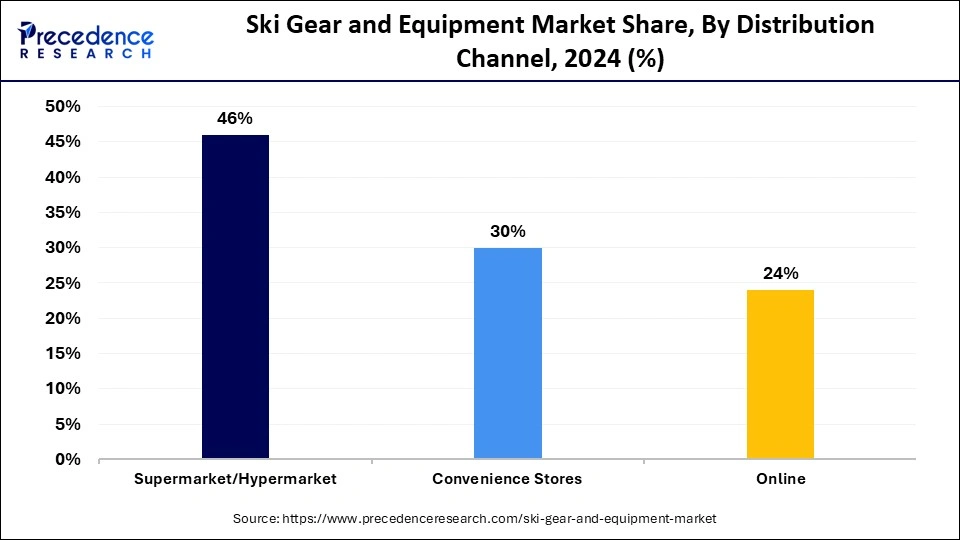
The online store segment is expected to grow at the fastest rate in the market during the forecast period, driven by the growth of direct-to-customer sales models, digital convenience, and e-commerce. With the advantages of doorstep delivery, AI AI-powered size recommendations, AR AR-based virtual fitting tools, and exclusive discounts, consumers are increasingly purchasing ski gear online. The markets for ski gear are expected to see rapid growth in the e-commerce sector as online retailers improve their product accessibility and user experience.
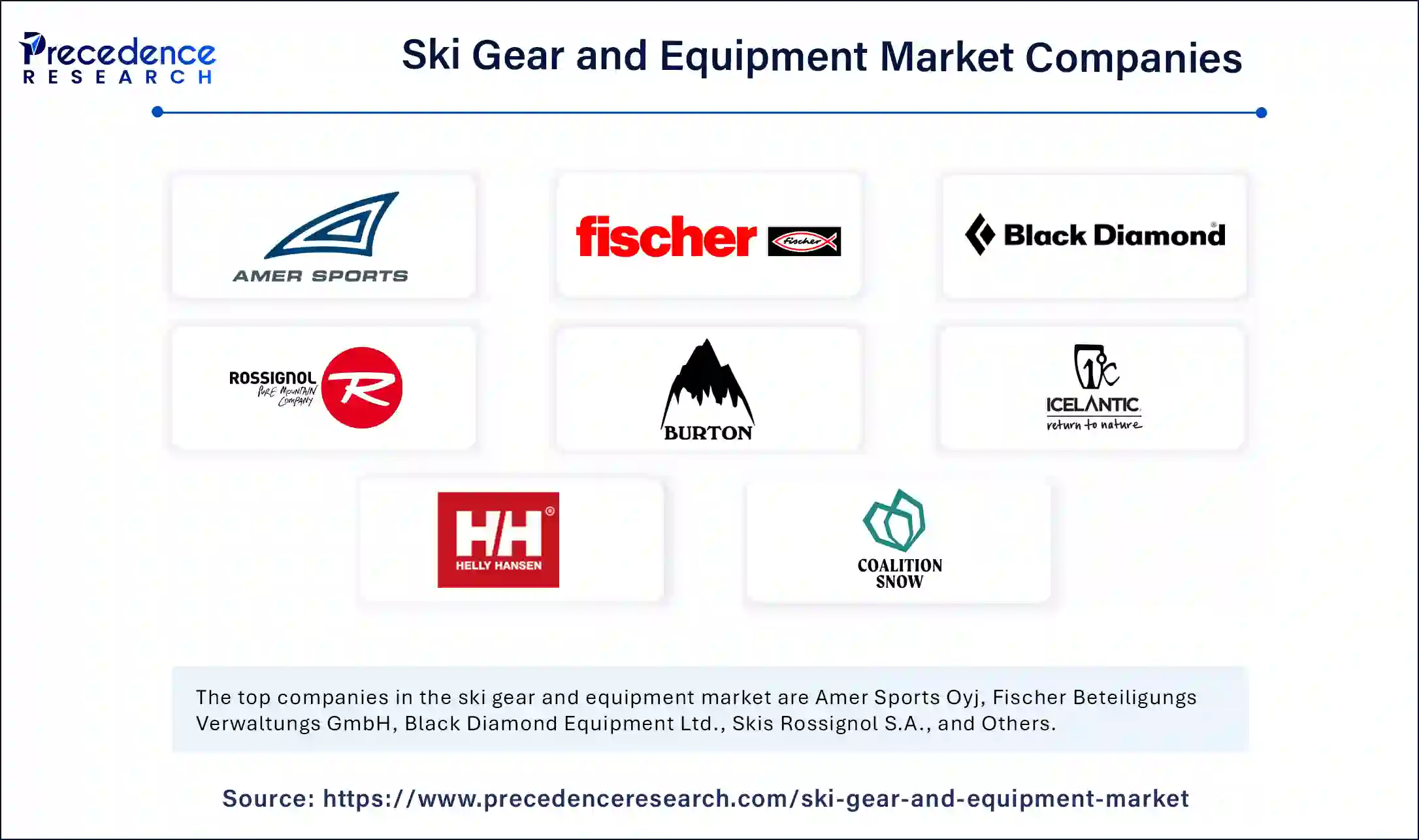
By Product
By Application
By Distribution Channel
By Geography
For inquiries regarding discounts, bulk purchases, or customization requests, please contact us at sales@precedenceresearch.com
No cookie-cutter, only authentic analysis – take the 1st step to become a Precedence Research client
February 2025
October 2024
November 2024
March 2025